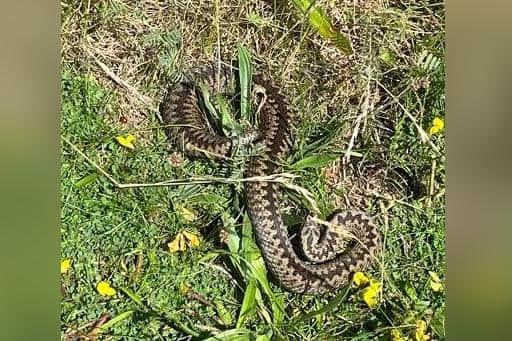Warning as dog bitten by large adder on Cinder Track near Ravenscar
and live on Freeview channel 276
Steven Swain, who has a static caravan at Grouse Hill caravan park, Fylingdales, said he and his wife Mandy were taking their 16-month-old Springer Spaniel, Harry – named after pop singer Harry Styles – out for a walk when he was bitten by the large mature adder.
Mr Swain said: “The snake was in short grass adjacent to the track which is not an area known for adder snakes.
"We phoned Beck Veterinary Practice in Whitby immediately.
Advertisement
Hide AdAdvertisement
Hide Ad

"They advised we carried the dog to the car and take him immediately to them and they would be waiting for him.
"Harry was subsequently hospitalised and treated by them before being released back to us 26 hours later.”
Mr Swain, who lives in Derbyshire, said before Harry was bitten, they had seen an elderly couple sitting on a bench on the track that was about two metres away from the snake – and were obviously quite oblivious to it.
Harry has since made a full recovery although Mr Swain added: “We don’t know what would have happened if he had not got to the vets on time.
Advertisement
Hide AdAdvertisement
Hide Ad

"By the time we got Harry to the car, he was in shock and very sleepy.
"But he is a young dog and fairly fit.”
The adder Vipera berus is a small, native viper found within the North York Moors National Park and is the only species of snake indigenous to the area.
Although timid creatures, people are being urged to take care where adders can be found.
Elspeth Ingleby, Senior Ecologist for the North York Moors National Park Authority, said: “Adders are found in a variety of habitats but are most likely to be found in open, shrubby landscapes such as moorland or areas of cleared plantation forestry where there are places to bask, plus plenty of vegetation to hide in and search for food.
Advertisement
Hide AdAdvertisement
Hide Ad“They are a shy species that will in general avoid people but may however bite if threatened and unable to escape.
"It is therefore advised that the public take care, particularly with dogs, in areas where adders may be found.
"Adders are active from March to October, so if visiting sites where adders may frequent, it is advisable to stick to footpaths or other unvegetated routes and keep dogs on a short lead or close to heal to avoid them coming across an adder in the undergrowth away from the path.
“If you encounter an adder, then either walk around it, giving a wide berth so that it doesn’t feel threatened, or stop and allow the animal time to move out of the path and into the undergrowth.
Advertisement
Hide AdAdvertisement
Hide Ad"Adders are a charismatic and vital part of the ecosystem, although populations are believed to have declined significantly in recent decades, largely due to habitat loss but also additional pressures such as disturbance and predation.”